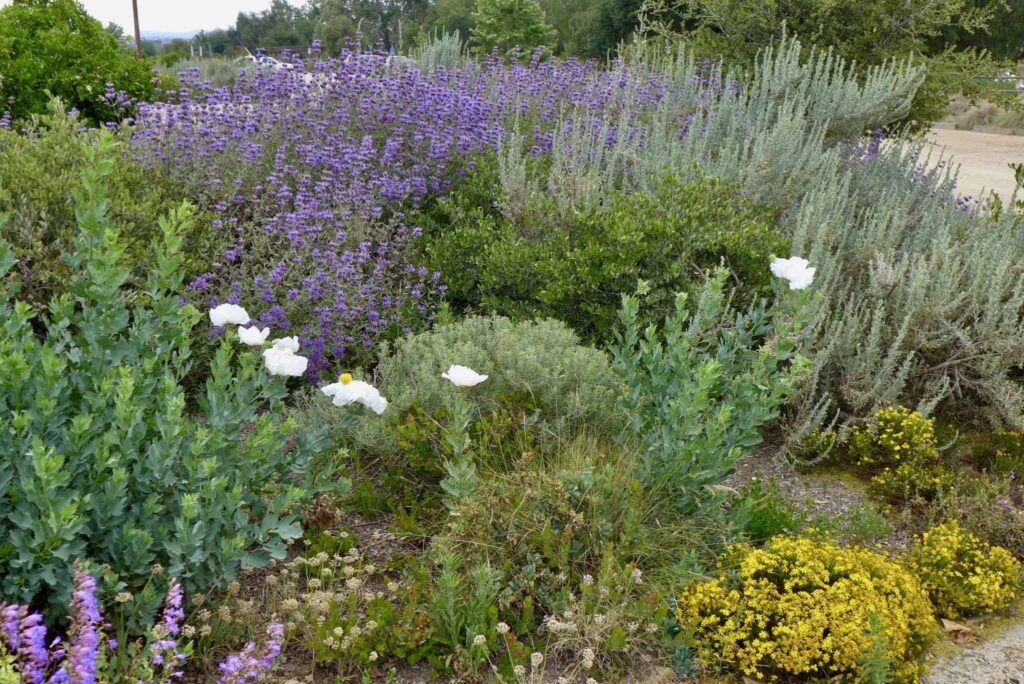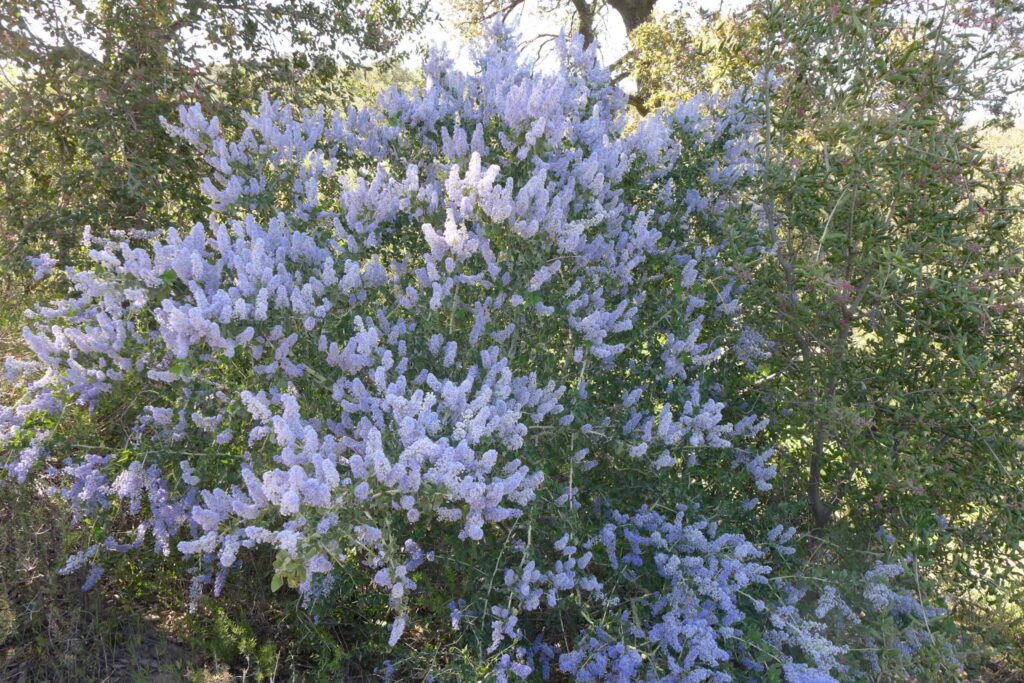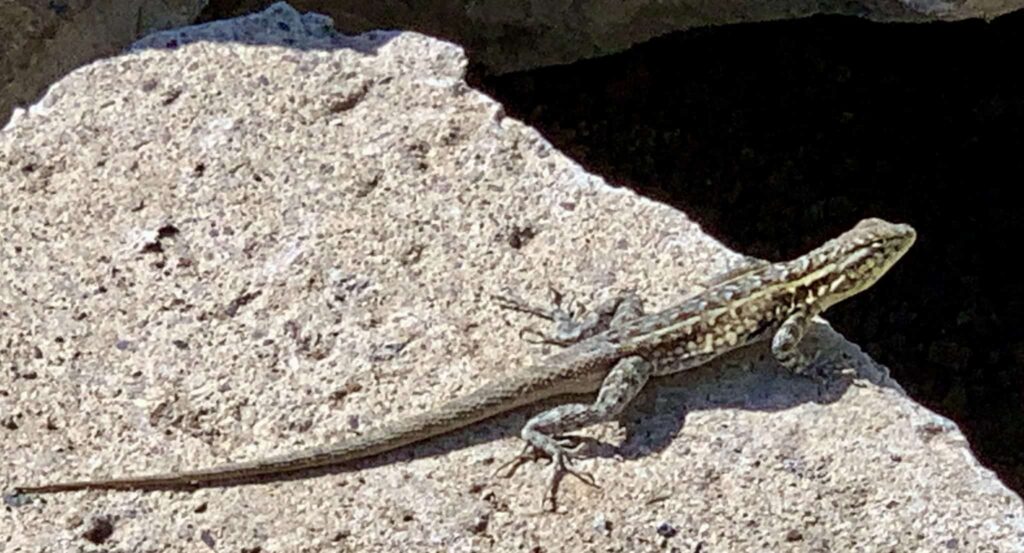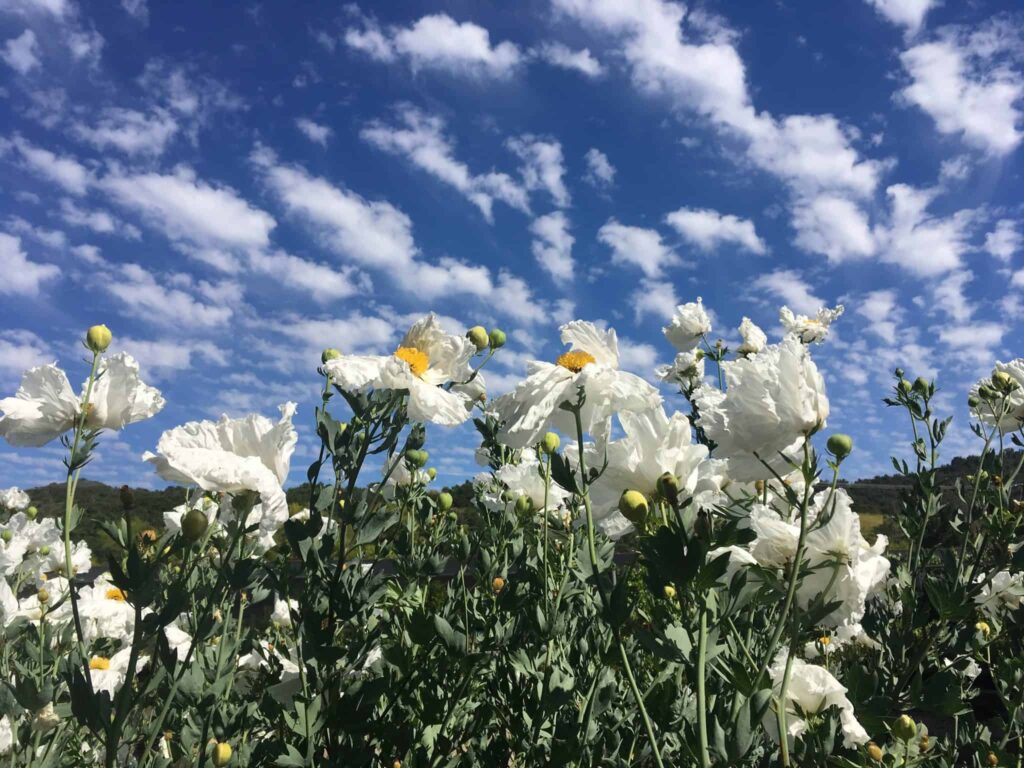May in the Natural Garden 2021
- Posted in: Blog, Monthly Garden Advice
- Tags Seasonal Gardening

May is the Pre-summer month when we kiss spring goodbye and open the door for the warm season to come in. The garden is abuzz. Birds and bees and every living thing are celebrating longer days and warm sunshine. This is when hummingbirds, ostensibly busy all the time, seem to never rest, feeding, mating, building nests, breeding, rearing young, and defending their territory. Occupied, but not preoccupied.
Current events, history, review, and notes
Reality check: Even if we were to get a nice half-inch rain this month, our season would finish with under 6 inches, which is less than half of “normal.” And it turns out our idea of “normal,” at least as far as rainfall average and water in the West are concerned, may have been based on a colossal miscalculation, one that was impossible to have caught as it was going down.
It’s possible that we are not so much entering a “mega-drought” as we are reentering the “normal” long-view climate regime for our region over the last 1200 years. We’re learning from tree ring data, and we may have just discovered that, in America’s movement westward over the last 150 years, we built a populous society on a giant weather anomaly. Assuming that rivers had always run as they did on discovery, and that glaciers and groundwater were never changing, we built our whole infrastructure, assuming as “normal” the water resources we found. But it’s quite possible we only chanced onto a particularly wet hundred years and that now we’re going back to our true normal, much drier; and because of climate change, much hotter as well. Who could have known?
Watering
Let’s review the Six Seasons in the Natural Garden
Fall – October, November – rains commence, many garden tasks, fall flowers.
Winter – December, January – rain, short cool days, calming dormancy, winter flowers.
Spring – February, March, April – more rain, birds, butterflies, life abounds, abundant flowers.
Pre-Summer – May – farewell cool and moist, hello hot and dry, transition month.
Summer – June, July, August – judicious watering, long hot days, seeds, summer blooms.
Post-Summer – September – farewell hot and dry, hello cool and moist, transition month.
This month we enter Pre-Summer, with not so much “cool and moist” to say goodbye to. It is super important to get and keep moisture in the root-zone depths of your soil before summer arrives. The scant rains have not been sufficient to properly prepare our gardens for the dry season. Use the TOLN “Deep Soak with Refreshing Sprinkles” method, starting this month (if you haven’t done so already). Plan on continuing through summer.
By review:
Deep Soak means running the sprinklers 30-40 minutes, each day for 2 or 3 consecutive days in the early morning to achieve slow water penetration to a depth of 14-18” or more. With most sprinkler systems, you will be applying the equivalent of 1.50” rain. You do a Deep Soak during cool overcast periods, especially before a predicted heatwave, approximately every 2 to 4 weeks depending on several factors. Use a soil probe or dig a few inspection holes to see if your soil needs water. If your soil is dry 4” deep in a small inspection hole in the root zone, it’s time for a Deep Soak.
Refreshing Sprinkles are fun as they get you out in your garden more frequently. With a spray nozzle on the garden hose, late in the afternoon, water all the leaves and soil surface with a 5-10 minute quick shower, a couple times a week or more. While this water will not penetrate into the root zone, it will cool the plants, the mulch, the soil surface and the entire area, and your plants will sleep with happy dreams, readying themselves for the next day’s heat. By the way, you will have happy dreams too. Turn the hose straight up and take a quick shower to see how good it feels on your plants.
Combine these two practices to achieve the now legendary “TOLN Deep Soak with Refreshing Sprinkles Method.”
You’re successful at this job when you utilize the method called “Occasional Deep Soak Plus Frequent Refreshing Sprinkles.” Give a Deep Soak when the soil is dry to the touch 4” down. Do “Refreshing Sprinkles” anytime.
Related to Watering
If your plants are newly planted, you cannot depend on the Deep Soak to water them. The root balls will dry out. You must use the hose and a soft rain nozzle to water each plant, concentrating on the nursery root ball, the planting hole, and the area outside the planting hole in ever expanding concentric circles. This should be done about once a week, (or more frequently with very small new plants), and you should spend 2-5 minutes or more on each plant, depending on the size of the plant. Your hose delivers 4-5 gallons per minute, so give your one and five gallon size plants 20 gallons or so when they need it. Continue until the plants become well rooted, approximately 3-6 months. In between hand waterings, Refreshing Sprinkles will help lock in that valuable soil moisture.

Pruning
As Ceanothus finishes blooming you can clean them up as if a deer were browsing. To get bushier plants, keep pinching the tips (tender spring new growth) on buckwheat, sage, sunflower, baccharis, ceanothus, etc. No major pruning or thinning this month. Shape all plants to get them ready for summer. Anytime you cut diseased wood, sanitize your tools with a solution of 10% household bleach between cuts. Periodically sanitize even when pruning healthy wood. Rinse your shears thoroughly before storing them.
Weeding
With your Deep Soaks might come a crop of summer weeds. Pull them or hoe them early while they are small.
Mulching/Top dress
If your soil is bare and you want a layer of top dress to help you through the summer, this is the last chance to apply it before it gets too hot. See our Mulch video for detailed information. If you have old tired organic mulch that is matting up because it is made of “sticks, strings, flakes and dust,” get it away from the stems and root zones of your plants or completely off site as soon as possible.
Be on the watch this year for extreme salt build-up in soils near you because of the lack of rain, with no fresh water leaching having taken place. Poor quality mulches will be quite saline after months of improper, shallow irrigation. Salty soil conditions, especially at the surface, predispose plants to warm season root rots and other diseases. You’ll see it all over town this summer, branch die-back and dead plants, but don’t let plants become victims. Get the bad mulch out of there before it’s too late.
Feeding
As I pen these words (a quaint old term), it is 95°. Still, you can get one more feeding in before summer if you act fast. Spread organic fertilizer through your garden and scratch it into the top half inch with a three-prong cultivator (good for the abs). Now wait for rain…. errrr ah, sorry, do a Deep Soak. Follow the directions on the bag regarding fertilizer application rates or cut them in half.
Troubleshooting – Varmints, Pests and Diseases
Pre-Summer is the season when beneficials are building their populations to deal with the bad guys. The best pest control is prevention and you can achieve this by making your garden healthy, the leaves turgid, growth strong, and root systems vigorous to resist injurious plant pests and disease. If you see aphids on new growth, blast them off. Crush any brown snails you find. See previous months posts regarding diagnosis and treatment of various pests. As a general rule, a healthy Natural Garden has few pest problems in summer. Diseases can be avoided by providing deep moisture in cool soils using the TOLN Deep Soak with Refreshing Sprinkles Method.
Annual Wildflowers
I hope you’re enjoying yours. Be sure to cut a few sprigs to take inside for the vase. Spring flowers came a little late in most gardens this year. And in the wild places, almost zero. As your wildflowers fade, permit the plants to dry in place. You can collect and store the seed or simply let it ripen and and fall to the ground for next year. In summer, I like to crumple up the dried plants, leaving most of the stems and leaves in place as a natural top dress, assuring that the seed will find its way into the soil. Enjoy.
Adding New Plants
There’s still time to add native plants in the cooler zones or in the shade. Of course desert plants can be handled in summer. If you’re planning a major project, like planting a big, hot, dry slope out yonder, unless you live near the beach, you may have just seen that time window shut for this year. You can plant new natives in pots all year.
Summer vegetables… ahhh yes. Perfect timing. Experiment. Just plant a tomato, chile, squash or melon out with your natives, guide the growth where you want it, and see how productive your ground can be. Or in the shade try a few leafy crops. This is fun, productive, and educational, with nutritious results. Also, don’t forget raised beds and containers. Come on over. We have many edibles to pair with your natives – like pairing fine wine with good food.

Engage
Rain gear got very little use this year. That’s OK… shorts, tee shirt and a sun hat are in order now. Get outside, into the wild places if possible, and wander a few steps off trail. Look under every big plant, beside every rock, on the little outcrops, and in all the nooks and crannies you find, to discover the hidden world of detail that nature tosses our way even in drought years, maybe even only in drought years. Don’t let the dust get you down. Crawl through it to get to a seep or spring, a shady cool spot, or a sunny boulder. And don’t rush. You’re sure to find inspiration on how to make your own Natural Garden more diverse, more special, and more secretive, by adding tiny details only you will know. Even crawling around in your garden, perhaps mundanely pulling weeds, will divulge unravelled mysteries. Get close to the ground.

Visit Tree of Life or a local native plant garden and to see Matilija poppy and Fremontia explode into color. Pause and watch flowering buckwheat, salvias, and sunflowers for a few hours and you’ll see a myriad of pollinators coming and going as if in shifts. Stop and listen to bird calls near and far. Study the hummingbird. Feel the breeze. Stay late, as tree frogs in the pond first position themselves, each in their own speaker box, amplifying their funny croaks. Spring is about gone. Summer is coming.
Hey, maybe we’ll get a few thunderstorms this season, such as we have missed for a long time. Any moisture sent from above would be wonderful, especially dramatic, steaming summer rain from the south. But no hurricanes, thank you.
For the times, they are a-changin’.
Not only are we gonna make it, we really are makin’ it!
From the May Garden,
Mike Evans

Romneya ‘White Cloud’
M is for May and May is for Matilija and Matilija is for Majesty.
Questions? Help is just one call or one email away. Call (949) 728-0685 or email (with pictures if you like) our special helpline: gardenhelp@californianativeplants.com